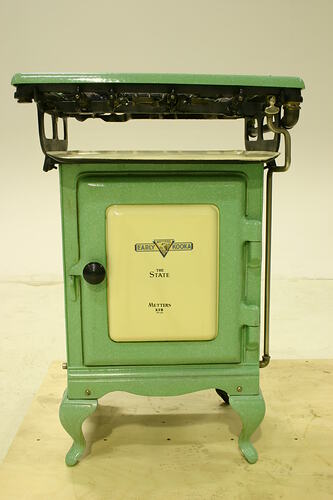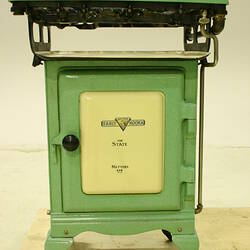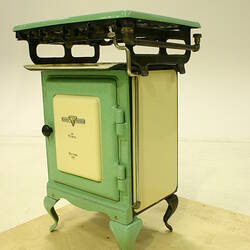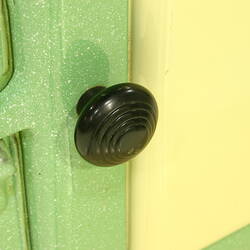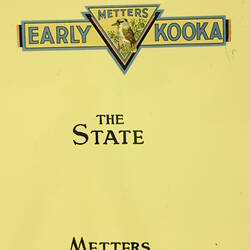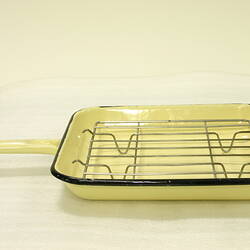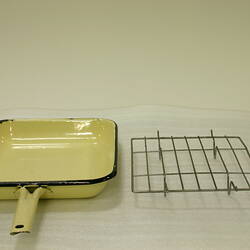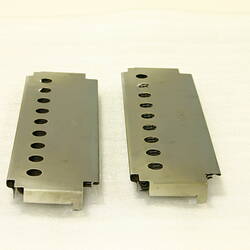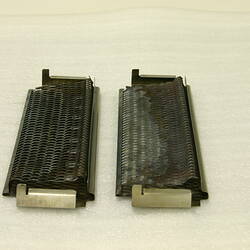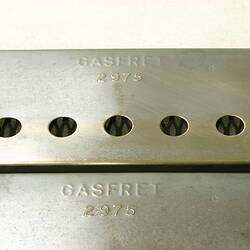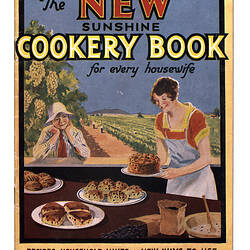Summary
Metters 'Early Kooka' gas stove, 'The State' model, in green and cream enamel. It was made by Metters KFB Pty Ltd, Footscray, Victoria.
The stove was used by the donor's mother in her North Caulfield house. It was already in the house when her mother bought it in the 1940s. Originally there was a wood fire stove as well as the gas Kooka stove in the kitchen. The gas was piped in and was switched to natural gas at some point. The gas Kooka was used until 2001 when the donor's mother moved to a nursing home. It had no temperature thermostat so cooking was done through familiarity with the heat of the stove. Between the 1950s and 1980s a small thermometer was used to check the temperature of the oven before baking cakes in it.
Physical Description
A gas powered, green and cream enamelled upright stove on 4 legs. TOP: 3 circular burners, 2 small at left and 1 large at right. 2 rectangular grill burners at centre. Hob made up of 3 removable panels of cast iron within mottled green enamel frame. Moulding on grill burners. FRONT: at top under hob, 4 black taps to control gas flow to burners. Upper right, silver metal switch connected to pipe which supplies the oven. Below hob, open grilling area. Removable yellow enable tray sits upon iron oven top. Oven, mottled green enamel body. DOOR: hinges at right, latch left centre. Central panel yellow enamel with company name and model details applied. HANDLE - black spherical knob left centre. INTERIOR: iron, 4 runners, 2 removable wire shelves, 1 removable sheet metal shelf. Base pierced holes along each edge. Long rectangular, gas burner loose at back. Door mottled black enamel. SIDES: under hob, side panels moulded. A brass disc attached to left. RIGHT: at left silver metal pipe runs from controls at top to base of oven. Upper left, pipe runs length of unit to connect to power supply. LEFT: lower right, silver metal, circular stopper. BACK: top centre, circular flue hole. Central panel with vertical decoration.
Significance
Solid fuel stoves continued to be manufactured for the Australian consumer throughout the early decades of the 20th century. In urban areas solid fuel was eventually replaced by gas or electricity.
Access to power supplies impacted significantly upon the market for gas and electric stoves. Though cooking in electric ovens was advertised from the outset as 'cleaner and more efficient', in the 1920s only 34% of all houses in Victoria were wired for electricity. Gas was available to many more Australian homes and consequently gas stoves, which were cheaper to purchase, cheaper to run, and required no installation fee, sold in greater numbers than electric stoves.
In the early 1920s, electric stoves were being imported into Australia. High tariffs meant these stoves were incredibly expensive; coupled with installation and running costs, it is not surprising that in 1923, only 0.1% of the population owned an electric stove. Despite the fact that over 80% of homes in Australia were wired for electricity by 1947, an estimate of electric stove ownership for 1955 indicates take up to be low: 36% of homes in Brisbane, 25% in Sydney and 24% in Melbourne. (Dingle 1998)
More Information
-
Collecting Areas
-
Acquisition Information
Donation from Ms. Jill Miller, Sep 2004
-
Manufacturer
Metters - KFB Pty Ltd, circa 1926
Australian Home Beautiful, July 1926. -
Place & Date Used
Caulfield North, Greater Melbourne, Victoria, Australia, 1940s or later
-
Inscriptions
TOP: on grill burners "GASFRET/ 2975". FRONT: DOOR: upper centre triangle with "METTERS" above colour image of a kookaburra in a tree, flanked on either side "EARLY" "KOOKA". Middle Centre "THE/ STATE". Lower centre "METTERS? KFB/ PTY/ LTD" SIDES: on both grill sides "METRO RH". On disc applied to grill at left "METROPOLITAN GAS COMPANY/ No M/ 60271"
-
Classification
-
Category
-
Discipline
-
Type of item
-
Object Measurements
54 cm (Length), 62 cm (Width), 91.8 cm (Height)
-
References
Dingle, Tony. 1998. "Electrifying the Kitchen in Interwar Victoria". Journal of Australian Studies, 57: 119-127
-
Keywords
